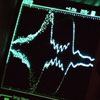« Previous | Next »
Lecture Topics
 |
- Propagation between Plates
- Phase and Group Velocity
- Standing Waves/Resonance in Cavities
|
Learning Objectives
By the end of this lecture, you should:
- find the group and phase velocity for propagation between plates or in a waveguide.
- discuss the effect of polarization on boundary conditions.
- apply boundary conditions to find resonance conditions for EM waves in a conducting box.
- apply boundary conditions to find resonance conditions for sound in a box.
Lecture Activities
Check Yourself
- In the demo of the sound cavity at the end of the lecture, it was mentioned that "polarization does not come into play". Discuss some general aspects of EM waves in a box and why the solution could be more complicated than with sound.
As discussed, the solution\[{E_x} = {E_{{0_x}}}\sin ({k_y}y)\sin ({k_z}z)\cos \omega t\]would apply in a box if \({E_x}\)is zero at the y and z boundaries, which give conditions on the k vector. However, any linear superposition of electric fields is possible, so similar solutions and restrictions could apply in the other directions. The cavity could have independent modes of oscillation for each of the three directions possible for the electric field.
- If 30 GHz EM radiation is directed into a pair of plates like those in the lecture, spaced by 1.5 cm, what transmission can take place, depending on exact conditions? (Note that 30 MHz was chosen to make calculations easier, but you should try to answer without explicitly doing calculations).
- The n=3 mode will be at cutoff, the n=2 mode could be present as one full-wavelength standing wave between the plates with propagation parallel to them.
- The n=1 mode could be present as a half-wavelength standing wave between the plates, with propagation parallel to them and at larger wave number than the n=2 mode.
- In the closed box with the field \[{E_x} = {E_{{0_x}}}\sin ({k_y}y)\sin ({k_z}z)\cos \omega t\]discussed in the lecture, the normal component is not zero everywhere at the walls x=0 and x=a. What best describes the situation on these walls?
A normal electric field is associated with a surface charge \(\sigma = {\varepsilon _0}E\). At most points on these walls, there will be a surface charge which varies with position and oscillates sinusoidally in time. In fact, \[\sigma = {\varepsilon _0}{E_x} = {\varepsilon _0}{E_{{0_x}}}\sin ({k_y}y)\sin ({k_z}z)\cos \omega t,\] which will in general have nodal lines and regions of positive and negative surface charge at the same time.
« Previous | Next »


